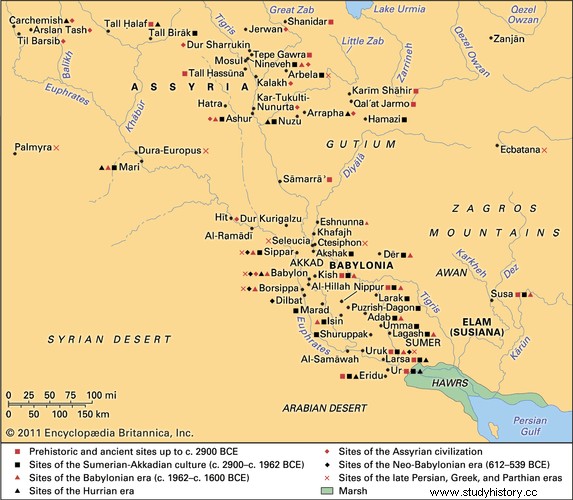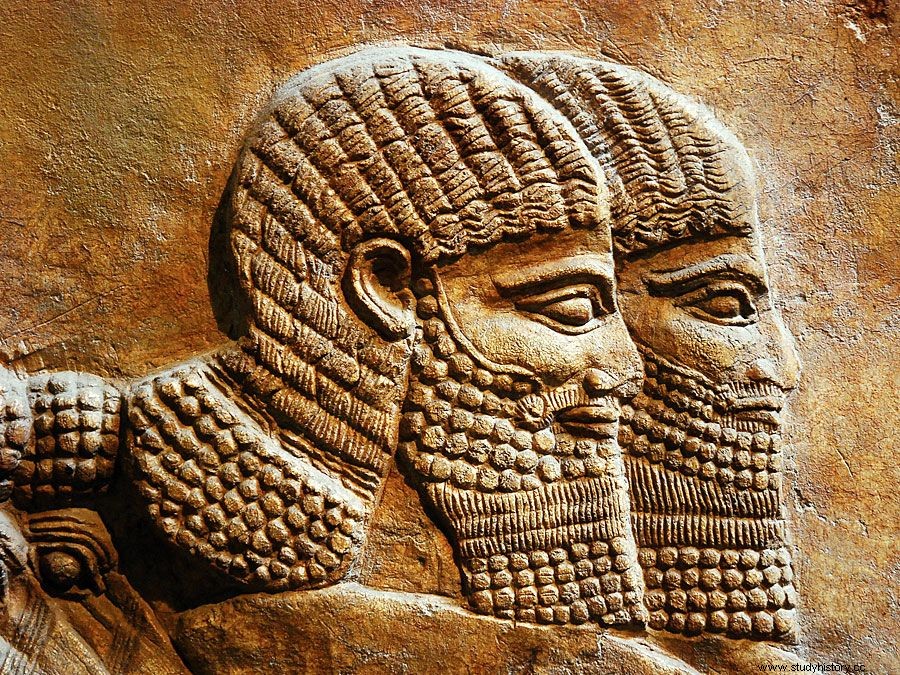
History of Mesopotamia , history of the southwest region of Asia where the earliest civilization developed worldwide. The name comes from a Greek word meaning "between rivers", referring to the land between Tigris and Euphrates However, the region can generally be defined to encompass the area that is now East Syria , the southeast of the Turkey and most of the Iraq includes . The region was the center of a culture, whose influence spreads across the Middle East and the Indus Valley, Egypt and the Mediterranean Sea.

 Britannica Quiz Middle East Geography Quiz Where is the Sea of Galilee located? Where is Mesopotamia? Take this quiz and test your geographic literacy.
Britannica Quiz Middle East Geography Quiz Where is the Sea of Galilee located? Where is Mesopotamia? Take this quiz and test your geographic literacy. This article covers the history of Mesopotamia from prehistoric times to the Arab conquest in the 7th century ce . On the history of the region in the following periods see Iraq history of . Find a discussion of the religions of ancient Mesopotamia see Mesopotamian religion . See also Art and Architecture, Mesopotamia .
Mesopotamia to the end of the Old Babylonian period
The origins of Mesopotamian history
The background
Strictly speaking, Mesopotamia is the area between the Euphrates and Tigris rivers north or northwest of the Baghdad Gorge in modern Iraq; It is Al-Jazīrah ("The Island") of the Arabs. South of it is Babylonia , named after the city Babylon . Broadly speaking, however, the name Mesopotamia is used for the area northeast of the Zagros Mountains and bounded on the south-west by the rim of the Arabian Plateau and is divided by the Persian Gulf in the southeast to the foothills of the Anti-Taurus Mountains in the northwest. Latitude only Baghdads will Euphrates and Tigris really twin rivers, the Rāfidān of the Arabs, who have constantly changed course over the millennia. The deep level of The Kārūn River in Persia was has always been closely related to Mesopotamia, but is not considered part of Mesopotamia as it forms its own river system.
Mesopotamia, south of Al-Ramādī (approximately 70 miles or 110 kilometers west of Baghdad) on the Euphrates and Tigris bends below Sāmarrāʾ (approx 70 miles north-northwest of Baghdad), is flat alluvial land. Between Baghdad and the mouth of the Shaṭṭ al-ʿArab (the confluence) from the Tigris and Euphrates, where it flows into the Persian Gulf, there is a height difference of only about 30 meters. Due to the slow flow of water, there are heavy silt deposits and the riverbeds are being raised. Consequently, rivers often overflow their banks (and may even change course) unless protected by high dikes. More recently they have been regulated above Baghdad through the use of escape channels with overflow reservoirs. The extreme south is a region of extensive swamps and reed swamps. hawr s that have probably served as a haven for oppressed and displaced peoples since earliest times. The water supply is not regular; Due to the high average temperatures and the very low annual precipitation, the soil of the 35° north latitude plain is hard and dry and unsuitable for plant cultivation for at least eight months of the year. Consequently, Farming without the risk of a crop failure in the 10th millennium v . Ch. in the areas with appears to have started with higher rainfall and on the hilly borders of Mesopotamia began in Mesopotamia itself, the very heart of civilization, only after artificial The irrigation was invented and brought water to large areas via an extensive network of canals. Since the soil is extremely fertile and abundantly produced with irrigation and the necessary drainage, southern Mesopotamia became a land of plenty, capable of supporting a sizable population. The cultural superiority of northern Mesopotamia, possibly dating back to about 4000 v. , was eventually overtaken by the South as people there responded to the challenge of their situation.
Current climatic conditions are quite similar to those of 8,000 years ago. An English survey of ruined settlements in the area 30 miles from antiquity Hatra (180 miles northwest of Baghdad) has shown that the southern limits of the zone where agriculture is possible without artificial irrigation is, have remained unchanged since the first settlement of Al-Jazīrah.
The availability of Commodities is a historical factor of great importance, as is the dependency on the materials that had to be imported. In Mesopotamia, agricultural products as well as products from livestock, fisheries, Date palm cultivation and the reed industry - in short grain, vegetables, meat, leather, wool, horn, Fish , dates, reed and plant fiber products abound and could easily be produced beyond home use to be exported to will. There are sources of bitumen at Hīt (90 miles northwest of Baghdad) on the Euphrates (Is of Herodotus). On the other hand, wood, stone, and metal were rare or non-existent. The date palm - effectively the national tree of Iraq - provides a wood only suitable for rough beams and not for finer work. Southern Mesopotamia mostly lacks stone , although Limestone is quarried in the desert about 35 miles west and "Mosul Marble" is found not far from the Tigris River in the central area. Metal can only be won in the mountains, and the same goes for Gems and semi-precious stones. As a result, southern Mesopotamia in particular was intended as a trading country from the very beginning. Rarely have "empires" spread over a large area secure imports by pillaging or subduing neighboring regions.
The resource that embodies the Mesopotamian civilization is sound :in which almost exclusively consists of mud brick architecture and in the number and variety of clay figures and pottery Artifacts , Mesopotamia bears the stamp of tone like no other civilization of the case is, and nowhere in the world , but in Mesopotamia and the areas , through which its influence was diffused, clay was used as the vehicle for Write . Such phrases as cuneiform civilization, Cuneiform literature and cuneiform law can only be applied when people had the idea to soften clay not only for bricks and glasses and for the glass caps on which a seal could be imprinted as a mark of ownership but also as a vehicle for engraved characters to which established meanings were attached - a intellectual Achievement that meant nothing less than the invention of writing.
